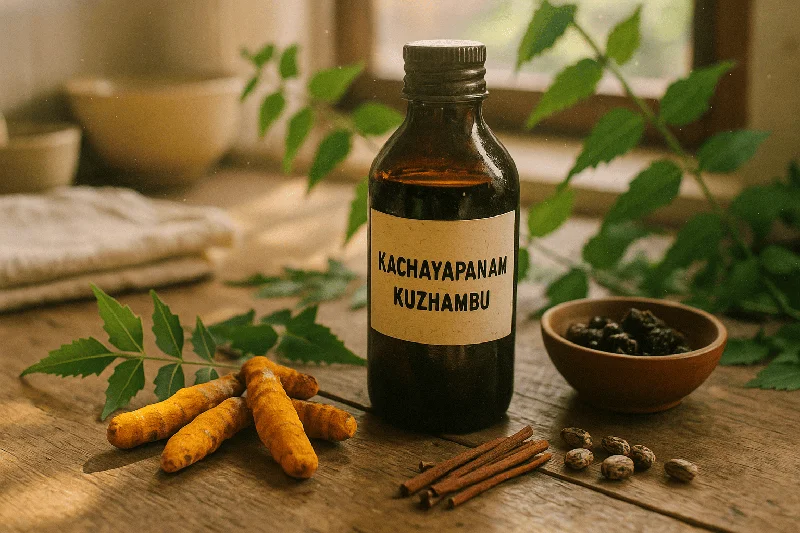Ask Ayurvedic doctor a question and get a consultation online on the problem of your concern in a free or paid mode. More than 2,000 experienced doctors work and wait for your questions on our site and help users to solve their health problems every day.
Shop Now in Our Store
Kachayapanam Kuzhambu: An Ayurvedic Marvel for Holistic Healing

Ayurveda has gifted us numerous remedies for managing various ailments and improving overall health. One such remarkable formulation is Kachayapanam Kuzhambu. Known for its therapeutic properties, this Ayurvedic preparation holds a significant place in traditional medicine. Let us delve into the details of Kachayapanam Kuzhambu, its benefits, uses, and preparation, to understand how it can contribute to your health and well-being.
What is Kachayapanam Kuzhambu?
Kachayapanam Kuzhambu is a unique Ayurvedic herbal oil known for its potent healing properties. It is widely used in the treatment of skin disorders, joint pain, and various inflammatory conditions. The oil is prepared using a blend of powerful Ayurvedic herbs and oils, making it a holistic remedy for external and internal ailments.
This therapeutic oil is revered for its ability to balance the body’s doshas (Vata, Pitta, and Kapha) and promote overall wellness. It is particularly effective in addressing skin problems, alleviating pain, and enhancing circulation.
Key Ingredients of Kachayapanam Kuzhambu
The effectiveness of Kachayapanam Kuzhambu lies in its rich combination of Ayurvedic ingredients. Here are the primary components:
-
Turmeric (Curcuma longa): Known for its anti-inflammatory and antiseptic properties, turmeric helps in soothing skin conditions and reducing swelling.
-
Neem (Azadirachta indica): Neem is a powerful herb for detoxifying the skin and treating various skin disorders, including eczema and psoriasis.
-
Castor Oil (Ricinus communis): Castor oil is a natural emollient that moisturizes the skin, alleviates dryness, and reduces inflammation.
-
Coconut Oil: Renowned for its cooling and hydrating properties, coconut oil soothes irritated skin and promotes healing.
-
Manjistha (Rubia cordifolia): This herb is effective in purifying the blood and enhancing skin health.
-
Guggulu (Commiphora mukul): Guggulu is an excellent anti-inflammatory agent that aids in reducing joint pain and swelling.
-
Sesame Oil (Tila Taila): This base oil is a vital component in most Ayurvedic formulations for its ability to penetrate deep into the skin and enhance the effectiveness of other ingredients.
Benefits of Kachayapanam Kuzhambu
The regular use of Kachayapanam Kuzhambu offers a plethora of health benefits. These include:
-
Treats Skin Disorders: The antiseptic and healing properties of its ingredients help manage various skin conditions like eczema, psoriasis, and acne.
-
Relieves Joint Pain: Its anti-inflammatory properties make it effective in reducing joint pain, swelling, and stiffness.
-
Enhances Skin Health: The herbs in this formulation detoxify and rejuvenate the skin, leaving it healthy and glowing.
-
Promotes Wound Healing: The oil accelerates the healing of cuts, burns, and wounds due to its antiseptic properties.
-
Balances Doshas: It helps in balancing the Vata and Pitta doshas, which are often associated with skin and inflammatory issues.
How to Use Kachayapanam Kuzhambu
The application and usage of Kachayapanam Kuzhambu depend on the condition being treated. Here are some general guidelines:
-
For Skin Disorders:
-
Take a small quantity of the oil.
-
Apply it gently over the affected area.
-
Leave it on for 20-30 minutes before washing off with warm water.
-
-
For Joint Pain and Stiffness:
-
Warm the oil slightly.
-
Massage it gently over the painful joints.
-
Cover the area with a warm cloth to enhance absorption.
-
-
For General Skin Care:
-
Mix a few drops of the oil with your regular moisturizer or use it as a standalone product for hydrating the skin.
-
Preparation of Kachayapanam Kuzhambu
While Kachayapanam Kuzhambu is readily available in Ayurvedic stores, it can also be prepared at home. Here is a simple method:
Ingredients:
-
Turmeric: 50 grams (dried and powdered)
-
Neem leaves: 100 grams
-
Castor Oil: 200 ml
-
Coconut Oil: 200 ml
-
Manjistha powder: 25 grams
-
Guggulu: 50 grams
-
Sesame Oil: 500 ml
Method:
-
Grind the herbs into a fine powder.
-
Heat sesame oil in a pan and add the powdered herbs.
-
Stir the mixture on low heat for 30-40 minutes until the herbs are well infused.
-
Strain the oil to remove the residue and store it in a clean, airtight container.
Precautions and Side Effects
Although Kachayapanam Kuzhambu is a natural remedy, it is essential to follow these precautions:
-
Patch Test: Conduct a patch test before using it on large skin areas to avoid allergic reactions.
-
Avoid Internal Use: This oil is meant for external application only.
-
Consult an Expert: Pregnant women, lactating mothers, and individuals with sensitive skin should consult an Ayurvedic practitioner before use.
Conclusion
Kachayapanam Kuzhambu is a powerful Ayurvedic formulation that offers a natural solution to various skin and joint-related issues. Its unique blend of ingredients and holistic approach makes it an essential remedy for maintaining overall health and well-being.
If you are looking to explore Ayurveda’s healing potential, Kachayapanam Kuzhambu could be a game-changer. Embrace this time-honored remedy and experience the transformative benefits it brings to your health.
This article is checked by the current qualified Dr Sujal Patil and can be considered a reliable source of information for users of the site.

